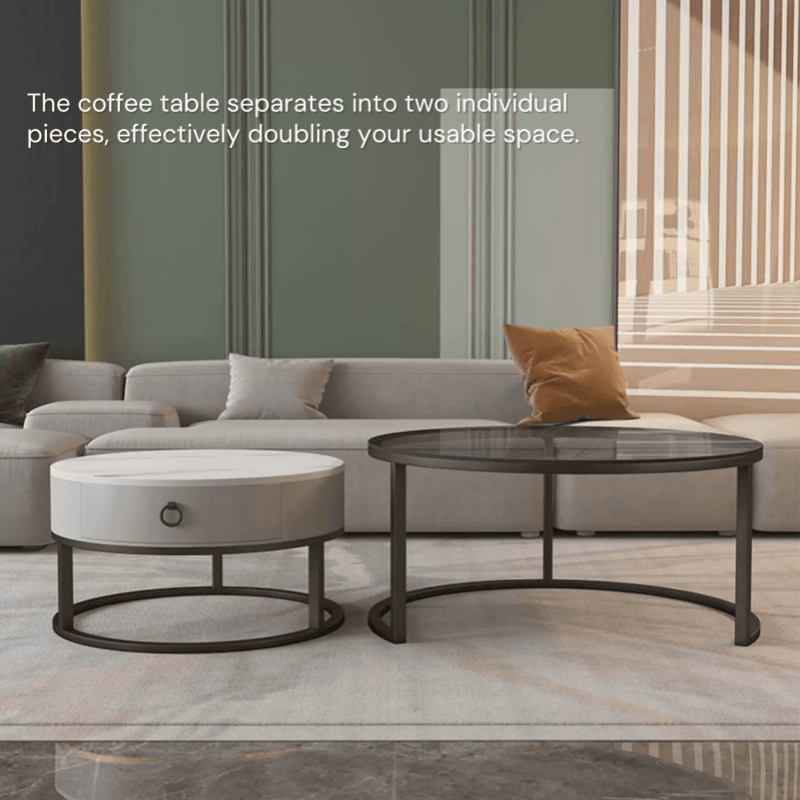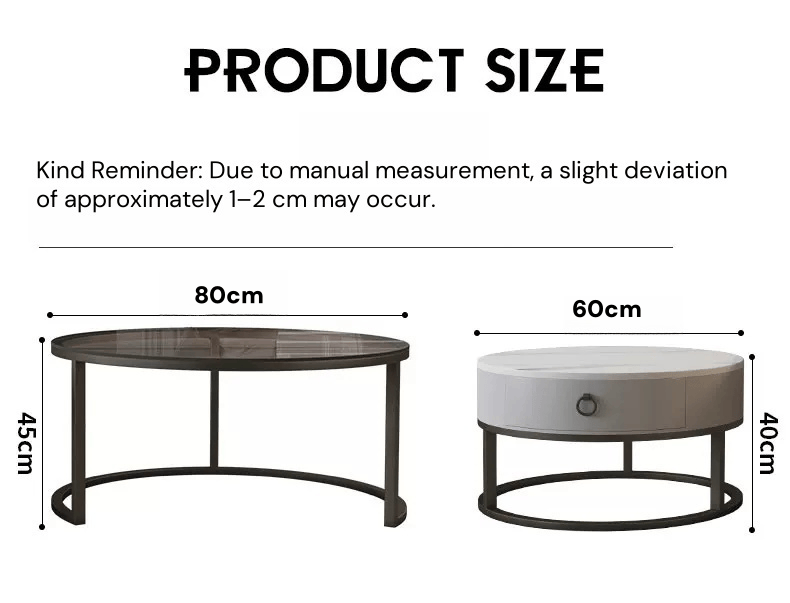Rock Slab & Glass Coffee Table – A Modern Centerpiece with Dual-Layer Elegance
Elevate your home with the Rock Slab & Glass Coffee Table, a striking blend of modern form and versatile function. This round table features a stunning two-tier design, combining a pristine white rock slab top with a transparent glass layer. Clean lines, subtle textures, and smart materials make this piece more than just a table—it’s a modern accent that speaks to both luxury and practicality. The balanced use of engineered stone and tempered glass introduces lightness and depth, reflecting a minimal yet thoughtful aesthetic. Ideal for living rooms, lounges, or open-plan interiors, this unique table brings elegance into everyday moments without overwhelming your space.
Crafted with intelligent design, this circular table comes in two stackable sizes: 80×80×45 cm and 60×60×38 cm. Use them together for a layered look or nest them when space is tight—they only occupy 0.64 square meters when stacked. This thoughtful feature makes the table perfect for compact homes or multifunctional areas. The rock surface resists heat, stains, and scratches, while the clear glass enhances the overall sense of openness. Both materials are easy to maintain, ensuring long-term beauty and usability.
The base of the table is made from strong black iron with a minimalist frame. This adds a bold, industrial edge and contrasts elegantly with the sleek tabletop. The sturdy structure provides excellent weight support and complements a variety of modern, urban, and Scandinavian styles. Whether you’re serving guests or showcasing your favorite décor, this piece performs with understated flair. It’s a balanced fusion of form and function—a statement of good taste that adapts to your lifestyle.
Choose this table for a refined addition to your home—an artful surface that transforms space without clutter.
Crafted for Style – Sleek Round Table with White Stone and Iron Base
This contemporary coffee table redefines living room furniture with smart design and premium materials. The white slab and glass layers create a dynamic focal point while allowing light to flow freely in your space. Its round shape softens harsh edges, ideal for family-friendly environments. The metal frame supports both style and function, making it a lasting piece in any modern setup.





How to Ship Furniture from China?
Shipping costs can represent a significant portion of the landed cost of your goods. Properly managing the transportation process will help you reduce overall expenses.
Full Container Load (FCL) vs. Less Than Container Load (LCL)
-
FCL (Full Container Load) refers to shipping a full container, which is generally the most cost-effective method, especially for larger shipments. A 40-foot container, for example, offers substantial savings in comparison to other shipping methods.
-
LCL (Less Than Container Load) involves shipping goods that don’t fill a full container, meaning your goods will share space with other shipments. While LCL can be more expensive, it’s a suitable option for smaller shipments. Sin embargo, LCL comes with additional fees. Unless you have urgent shipments, it's generally better to opt for FCL.
That said, there are exceptions. Sometimes, LCL may be cheaper than FCL, especially when ocean freight rates are unreasonable (e.g., during the second half of 2020), or if you're considering a 20-foot container, in which case LCL can be more cost-effective.
Choosing the Right Incoterms
When engaging in international trade, it’s crucial to understand the main Incoterms used: EXW, FCA, FOB, CIF, DAP, DDP. Each term outlines the responsibilities of both the buyer and the seller, and choosing the right one impacts both cost and risk.
- FOB (Free On Board) is the most common term, but some furniture buyers prefer CIF or DDP (Delivered Duty Paid).
- In the case of LCL shipments, many factories only accept EXW (Ex-Works) terms, meaning you’ll need to handle the pickup from the factory warehouse and manage the rest of the logistics yourself.
Collaborating with a Reliable Freight Forwarder
International shipping is a complex process with potential delays and unforeseen issues. Partnering with a reputable freight forwarder who understands the import process can help you navigate challenges smoothly. It’s advisable to find a local agent familiar with your country’s import regulations.
How to Calculate Landed Costs
Landed cost is essential in determining whether your pricing strategy is suitable for your furniture business. It typically includes the following:
- Product cost.
- Local charges and customs fees at the supplier’s location (if EXW terms are used).
- Ocean freight.
- Insurance.
- Import duties and taxes.
- Destination local charges.
Landed costs can vary depending on the destination country. Would you like to review your specific landed costs? Feel free to get in touch, and we can discuss it further.
Shipping Documentation
Proper documentation is a key component of international shipping. Before booking a container, ensure you have all required documents ready:
- Commercial invoice and packing list.
- Bill of lading.
- Certificate of origin.
- If your goods involve wooden packaging, a fumigation certificate might be required.
- Any additional documents related to your custom orders.
Tip: For certain countries, such as Australia, Pakistan, and Southeast Asia, buyers may be eligible for tax exemptions or reductions if the supplier can provide an FTA (Free Trade Agreement) certificate of origin. Be sure to ask your supplier.
Shipping Timeframes
Understanding the shipping timeline is critical to planning your inventory. Consider these three factors:
-
Production time: Furniture items like sofas or bed frames typically take 20-30 days to manufacture, while flat-pack items usually take 40-60 days.
-
Shipping duration: Depending on the destination, shipping can take anywhere from one week to 40 days.
-
Delays: Unexpected delays may occur due to factors such as container shortages or customs inspections. While these are out of your control, it's best to prepare for such contingencies.





 Furnventa al por mayor
Furnventa al por mayor





















